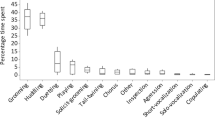Abstract
Patterns of social behavior of the chimpanzees of the Mahali Mts. are listed briefly in this paper, where behavior absent in the other subhuman primates is especially focussed upon. Some are more analogous to those of mankind than to those of the other subhuman primates. This characteristic social behavior is more or less related to the peculiar social organization of wild chimpanzees. Differences of social behavior between two local populations (i.e., of the Mahali Mts. and the Gombe Stream Reserve) have not been recognized; namely, “dialect” differentiation does not seem to exist.
Similar content being viewed by others
References
Eibl-Eibesfeldt, I., 1969. The concept of ethology and its application to human behavior. Lecture at the Goethe Institut, Kyoto.
Goodall, J., 1963. My life among wild chimpanzees.National Geographic, 124 (2): 272–308.
——, 1965. Chimpanzees of Gombe Stream Reserve. In:Primate Behavior: Field Studies of Monkeys and Apes,I. DeVore (ed.) Holt, Rinehart & Winston, New York.
——, 1966. New discoveries among Africa's chimpanzees.National Geographic, 128 (6): 802–831.
--, 1968. A preliminary report on expressive movements and communication in the Gombe Stream chimpanzees. In:Primates: Studies in Adaptation and Variability,P. Jay (ed.) Holt, Rinehart & Winston.
Hall, K. R. L. &I. DeVore, 1965. Baboon social behavior. In:Primate Behavior,I. DeVore (ed.) Holt, Rinehart & Winston, New York, pp. 53–110.
Itani, J., 1954. Japanese monkeys at Takasakiyama. In:Nihon Dobutsu-Ki, II.K. Imanishi (ed.) Kobunsha, Tokyo.
——, 1959. Paternal care in the wild Japanese monkey,Macaca fuscata fuscata. Primates, 2: 61–93.
——, 1967. The social unit of chimpanzees.Primates, 8: 355–381.
Kawai, M., 1965. Newly-acquired pre-cultural behavior of the natural troop of Japanese monkeys on Koshima Islet.Primates, 6: 1–30.
Kortlandt, A., 1962. Chimpanzees in the wild.Sci. Amer., 206(5): 128–138.
Nishida, T., 1967. The society of wild chimpanzees.Shizen, 22(8): 31–41.
——, 1968. The social group of wild chimpanzees in the Mahali Mountains.Primates, 9: 167–224.
Reynolds, V., 1966. Open groups in hominid evolution.Man (n.s.), 1: 441–452.
——, 1965. Chimpanzees of the Budongo Forest. In:Primate Behavior: Field Studies of Monkeys and Apes,I. DeVore (ed.) Holt, Rinehart & Winston, New York.
Schaller, G., 1963.The Mountain Gorilla: Ecology and Behavior. The University of Chicago Press, Chicago and London.
Service, E., 1966. The hunters. Englewood Cliffs, N.J.: Prentice-Hall.
Author information
Authors and Affiliations
About this article
Cite this article
Nishida, T. Social behavior and relationship among wild chimpanzees of the Mahali mountains. Primates 11, 47–87 (1970). https://doi.org/10.1007/BF01730675
Received:
Accepted:
Issue Date:
DOI: https://doi.org/10.1007/BF01730675




